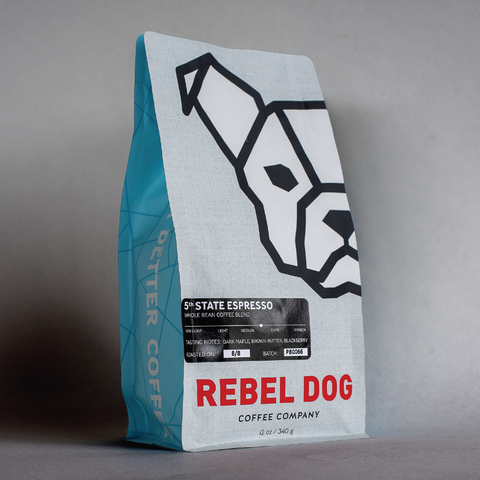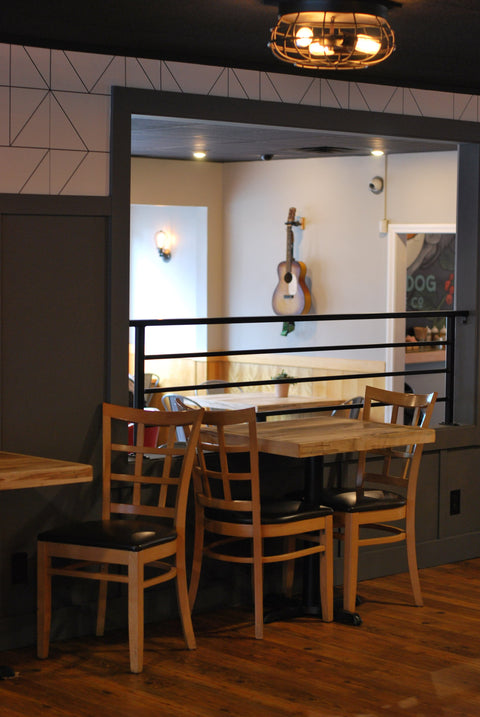What's in 5th State?
Varieties: Castillo, Caturra, Colombia
Growing Altitude: 2,100 masl
Processing Method: Washed
Sourced from the elevated terrains of Buesaco Nariño in southern Colombia, this exquisite coffee is cultivated at over 2,000 meters above sea level on average. Buesaco's unique geographic and climatic conditions, characterized by volcanic soil and an average temperature of 18.6 °C, provide an optimal environment for producing coffee with distinct mild taste, high acidity, and sweet notes.
The region’s coffee cultivation heritage dates back to the 18th century, growing over time to become an integral part of the local cultural, economic, and social fabric. With its first international exposure in the early 20th century, Buesaco Nariño's coffee has since been celebrated in the specialty coffee segment worldwide for its unparalleled quality, cultivated in the unique environmental conditions of the region.
As with many coffee origins, it is believed that coffee was first brought to Colombia by priests, arriving, perhaps, within a decade or two after coffee first came to the Americas via the Caribbean in the first half of the 17th century. It was likely a garden crop grown for local consumption and barter for decades. Unlike other coffee regions, we have the story of a priest named Francisco Romero, who could be called the father of commercial coffee cultivation in Colombia. The folkloric tale goes that in the early 1800’s, Father Francisco, hearing confessions in the north eastern town of Salazar de la Palmas, assigned planting coffee to his parishioners as penance for their sins. The Archbishop of Colombia heard about this and ordered all priests to adopt the practice. Commercial production of coffee expanded quickly, moving into regions where the growing conditions were ideal.
Even though it’s been 4,000 years, the soil resulting from the last major eruption of Tolima is still considered “young soil,” filled with nutrients that are no longer found at the same levels in old soil. There is a long list of elements on offer in volcanic soil that are fading or absent in other soils, such as high levels of potassium and nitrogen. Also present is something called “Boron,” which arrived from outer space a long time ago, and is important to cell walls, the creation of enzymes, and the production of flowers and fruit, meaning Boron contributes to yield. Beyond the nutrients, the structure of volcanic soil is also beneficial to coffee growing. It can soak up and hold moisture while, at the same time, facilitate good drainage so water doesn’t pool, which is not good for coffee plant roots. Coffee plants like to take a drink, then take a break. Also, volcanic soils are usually found on an incline, which also helps with drainage.
Varieties: Bourbon, Caturra
Growing Altitude: 1400–1600 masl
Processing Method: Washed
Manos de Mujer comes from the ACODIHUE cooperative in the mountainous territory of Cuchumatan, Huehuetenango near the border with Mexico. Manos de Mujer is grown and produced by indigenous women who are now the owners of their land as a result of widowing from a civil war and men migrating into the United States. ACODIHUE certified the women producers as Manos de Mujer (Women’s Hands) to recognize the hard work of these women and their contribution to both their households and to the national economy. One of the major benefits for producers belonging to ACODIHUE are the investments that the cooperative makes into the community. ACODIHUE recently launched a vegetable gardening skill building program where women can learn to farm their own vegetables to feed their families and also sell to local markets for extra income.
Only 22% of ACODIHUE's annual production goes under the designation of Café con Manos de Mujer, representing a refined selection of the cooperative's coffee. The ripe Manos de Mujer coffee is picked by hand during the harvest season, which begins shortly after Christmas and lasts until nearly Easter. The coffee is grown at an average elevation of 1500 meters above sea level. The most common varieties are Red and yellow Bourbon, as well as Typica and Caturra.
Living Income Pricing: 80% of the world’s coffee farmers live below the poverty line and current prices paid to farmers do not meet farmers’ livelihood needs. This coffee was purchased using Bellwether’s Living Income Pricing benchmark which ensures that coffee producers were paid a fair, sustainable wage. By purchasing this coffee you’re helping interrupt poverty among coffee farmers by paying a price that closes the living income gap.
Farmer Impact Fund: Bellwether’s Farmer Impact Fund further invests in coffee communities through direct balloon payments to producers who have autonomy to use the money on community and farm-level projects.
Through the Farmer Impact Fund the ACODIHUE cooperative launched a dental hygiene program for their members, 70% of whom are female farmers. Dental care in the Cuchumatan region of Guatemala is often either unattainable because of distance to the nearest clinic or cost prohibitive for coffee producers. To date, the funds provided through the Farmer Impact Fund have enabled 14 people—12 women, one man, and one child—to receive emergency dental care. Contribute to the Farmer Impact Fund today to continue investing in the producers of this region.
Varieties: Blue Mountain , Bourbon, SL28, Typica
Growing Altitude: 1600-1900 masl
Processing Method: Fully Washed
Vertical-integration and whole-harvest sourcing enable Sucafina to source Korongo’s 84+ SCA cup in significant volumes at an accessible price that supports roaster success and producer resilience. This lot is IMPACT verified and contributes to a Farmgate Initiative project.
The Korongo blend (named for the Swahili word for flamingo) is sourced from a network of washing stations across Mbozi, Mbeya & Mbinga, in Tanzania’s Southern Highlands. Selected by QC teams at our sister company in Tanzania, Korongo showcases Tanzania’s true potential, offering a consistent, fully traceable 84+ SCA cup available in large volumes. Vertical-integration and whole-harvest sourcing enable us to source Korongo at an accessible price that supports roaster success and producer resilience. Our Korongo displays the best of Tanzanian flavor profiles with a full body, pronounced sweetness and prominent acidity.
This Korongo lot is IMPACT verified. IMPACT is Sucafina's responsible sourcing standard that focuses on 5 key impact areas to improve carbon emissions, human rights, regenerative agriculture, living income and deforestation. Through IMPACT verification, farmers can access new markets and increase their livelihoods while making a bigger positive impact through their production.
In addition to growing coffee, farmers typically intercrop with corn, beans, groundnuts, sunflowers and ginger.
Cherry is hand-harvested. Farmer process cherry on their own farms, so individual processing methods vary from farm to farm. In general, cherry is pulped using either an eco-pulper or standard pulper and then fermented. Following fermentation, parchment is dried on raised beds for 14-20 days. Once dry, the parchment sits for 2-3 months in cooperative warehouses before being transferred to mills in either Mbozi or Mbinga, districts in Southern Tanzania, to be prepared for export.
Peaberry is a name given to a very specific shape of coffee bean. In Spanish, peaberries are called “caracol”, which means “snail”. The name aptly describes the shape of the peaberry bean, which appears slightly curved in on itself. Peaberries are the result of a natural mutation in the coffee cherry. Whereas there are usually two beans nestled together in each fruit, a cherry with a peaberry mutation only forms one bean. Thus, peaberries are a single, rounder bean.
Peaberry mutations occur in approximately 5% of all coffee. The beans are known for being rounder, smaller and denser, which can contribute to a more even roast color when handled correctly. Many people find peaberries to have a sweeter flavor profile, as well. Since peaberries are a natural mutation that is not visible from the outside of the cherry, peaberries must be sorted out during the screen grading stage of dry milling. The peaberry screens have the smallest holes, which are oblong to allow the rounder beans to fall through.
Varieties: Various
Growing Altitude: 800-1,100 masl
Processing Method: Natural, Pulped Natural
This 84+ scoring coffee is the result of an effort of Brazilian QC professionals selecting the best-tasting coffees from a variety of producers throughout the country to showcase the best of Brazilian coffee while providing a consistent and reliable income for farmers.
The rattlesnake, known as Cascavel in Portuguese, gets a bad rap. Its reactive tendency to defend itself from all perceived threats makes it a frightening opponent. But it’s also essential to the coffee ecosystem. In addition to their beautiful markings, rattlesnakes eat rodents and other small animals. They keep these pests far away from coffee fields where they could wreak havoc by burrowing into coffee tree root systems or chewing through irrigation setups.
Cascavel Vermelha (Portuguese for red) has lots of red fruit and refined sweetness. This coffee has been selected based on its fruity profile. In most cases, Natural processing connotes such flavors; however, this coffee may have some Pulped Natural contributions as well. Natural lots will be dried on large patios under sun, while Pulped Natural will be pulped and then laid to dry on patios. In both cases, the coffee will be raked and turned regularly to ensure even drying and a clean cup profile.






